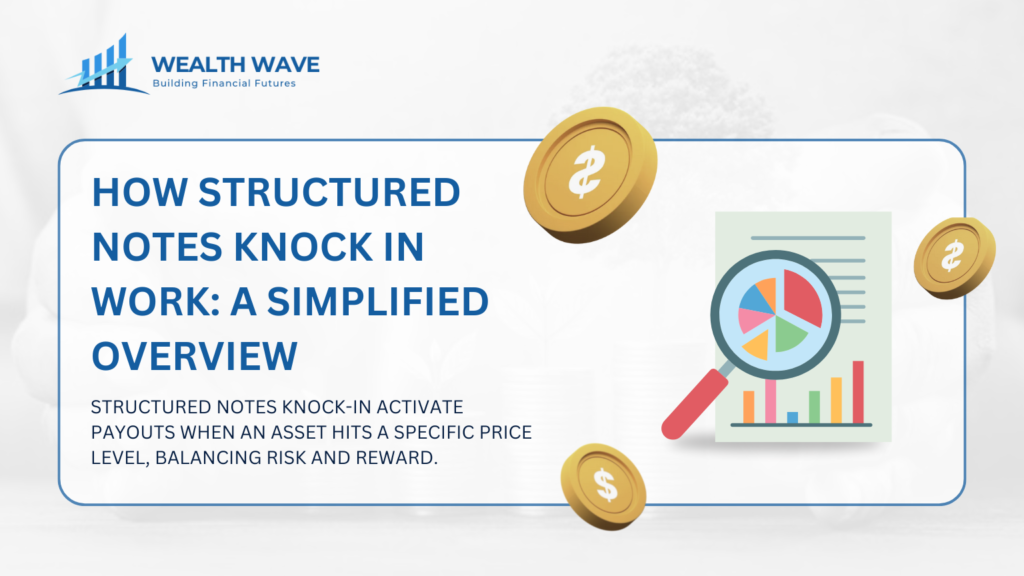
Ever found yourself staring at the vast sea of investment options, feeling a tad overwhelmed? You’re definitely in good company. Many of us grapple with finding that sweet spot between embracing risk and gunning for those high returns.
It’s a tricky balance, but here’s a little nugget of wisdom that might just light up your path: structured notes with knock in options have this unique twist where their payout return shifts when certain market levels are hit.
This discovery had us digging deeper to get the full scoop, and we’re excited to share our findings with you. Our blog is set to walk you through structured notes knock in.
We’ll spill the tea on their perks, like buffering against hefty losses, while also pointing out some potential pitfalls to keep on your radar.
Expect breakdowns in plain English that aim to simplify your investment journey. So if you’re ready for some clarity in this complex world of investing, stay tuned!
Key Takeaways
- Structured notes with knock in options become active when a market hits certain levels. This feature can offer protection against losses while allowing for potential high returns.
- These products combine the safety of bonds with the growth potential of derivatives based on stocks or indices. Investors must understand each note’s terms and risks due to their complexity.
- Knock in options come in two types: up-and-in, which activates when prices rise, and down-and-in, activated by falling prices. Both aim to manage investment risk while seeking rewards.
- Principal protection in structured notes aims to shield investors from full downside losses. However, if certain barriers are breached, total loss exposure may increase.
- Investing in structured notes requires careful consideration of performance factors, costs associated with issuance by banks, and liquidity concerns regarding access to funds before maturity.
Understanding Structured Notes

We often explore structured notes as a way to add diversity to our investment strategies. These financial tools combine traditional bonds with derivatives, offering us both potential growth and protection.
Definition of a Structured Note

A structured note combines a bond with one or more investment products. These financial instruments create debt securities that reflect both the safety of bonds and the potential for higher yields through derivatives.
Banks issue them to meet specific investor return profiles based on underlying assets or indices performance. This means we can invest in structured notes for a chance at returns tied to market movements while enjoying some level of principal protection.
Each note has its unique blend, including terms like maturity dates and protection levels. The complexity comes from these details, often stretching over dozens of pages. We see this as an opportunity but also acknowledge the challenge it poses in understanding each note’s structure and risks fully.
Types of Structured Notes

Structured notes come in various types. We see equity-linked notes as a popular option. These notes link their returns to the performance of stocks or indices. Callable yield structured notes represent another type.
They have a potential knock-out feature, which can impact returns.
We also find notes with principal protection. These instruments combine the features of a bond and investment products. They offer security while allowing for market participation.
Each type has unique specifications, such as protection levels and maturity terms. Investors must carefully consider these characteristics to make informed decisions.
Examples of Structured Notes Knock In options

We see knock in options offering different structures and opportunities. For instance, a knock-in option activates once the underlying asset reaches a specific price level. These options can be categorized into up-and-in and down-and-in types.
An up-and-in option comes into play when the price of the asset rises above a predetermined barrier. In contrast, a down-and-in option activates once the asset’s price drops below a set threshold.
Many structured notes contain these options, often blending features of equity-linked notes and traditional debt products. Callable yield structured notes may also include knock in options.
This combination allows investors to harness potential returns while managing risks. Each option comes with unique triggers that impact the payout return. Because structured notes can be complex, we find it essential to grasp the implications of these knock-in options clearly.
How Knock-In Options Work

Knock-in options activate when the underlying asset reaches a specific barrier level. These trigger points define whether we gain exposure to the option or not.
Barrier Levels and Trigger Points

Barrier levels and trigger points play a crucial role in structured notes. A specific price level, known as a barrier, may determine if the knock-in option becomes active. If we breach this level, the payout return changes on the note.
These levels function as safety nets, absorbing an initial percentage of losses. Yet, if the barrier is crossed, we may face full loss exposure. Markets can be volatile, so understanding these triggers helps us manage risk effectively.
Investing in such structured products, we must remain aware of these dynamics and their impact on our returns.
Up-and-In Vs Down-and-In Knock-In Options
Up-and-in knock-in options activate when the underlying asset price rises above a predetermined barrier level. Once this level is breached, the option behaves like a regular option.
These options can provide us with added leverage in a rising market, allowing for potentially greater returns.
Conversely, down-and-in knock-in options trigger when the asset price falls below a specific barrier. This option also becomes active, allowing us to benefit from market declines. Both types of knock-in options add complexity to our investment strategies.
They reflect our willingness to take on risk for possible rewards while ensuring we understand the associated market dynamics.
Comparison to Knock-Out Options
Knock-out options have some distinct differences from knock-in options. Knock-out options feature lower initial costs and offer safety during challenging market conditions. However, they limit profits and increase the chances of significant losses.
A knock-in option only behaves like a standard option once the price level reaches a set barrier or trigger before expiration. In contrast, a note with a knock-out feature can lose its value if the underlier breaches a specific level.
Both options require careful consideration, as they balance costs and risks uniquely.
Understanding these differences helps us make informed investment choices. Next, we will explore the benefits of knock-in options.
Benefits of Knock-In Options

Knock-in options offer principal protection, allowing us to minimize losses while still pursuing potential returns. They provide a strategic way to balance risk and reward in our investment portfolio.
We can leverage these options for greater financial flexibility and opportunities that fit our goals. Are you ready to explore the unique features of knock-in options?
Protection Against Full Downside Losses
Structured notes with principal protection help us avoid full downside losses. These financial instruments include a barrier level that absorbs an initial percentage of any loss the underlying asset experiences.
If the asset breaches this barrier, we may face the total loss of our investment. This risk management feature provides a safety net, making structured notes an appealing option for investors looking to mitigate risks during market volatility.
Knock-in options enhance our protection strategy when the barrier level is respected. As these options only activate once the specified price level is reached, they offer a unique way to engage with the market.
By understanding these mechanisms, we can make informed decisions about our investment strategies and gain potential benefits from structured products.
Potential for Higher Returns
Protection against full downside losses leads us to the potential for higher returns. Structured notes can offer significant rewards, especially through knock-in options. These options activate only when an underlying asset reaches a specific price level.
This feature allows us to benefit once the market aligns with our expectations.
Structured notes with principal protection give us a safety net. They help us avoid losing our entire investment. With knock-in options, the payout can increase notably if the underlying asset performs well.
Callable yield structured notes are another avenue for potential gains. They combine safety with the chance for higher returns. Investing wisely in these financial instruments enhances our investment strategies while managing risk.
Considerations When Investing in Structured Notes

When we invest in structured notes, we must weigh performance and cost carefully. Liquidity also plays a crucial role in accessing our funds. Understanding these aspects can significantly influence our investment strategy.
Keep reading to explore more insights on structured notes and knock in options!
Performance and Cost Factors
Structured notes combine various financial instruments. They often have complex specifications, including performance factors and costs. We should examine these aspects closely. Performance hinges on the underlying assets or indices.
If these perform well, our returns may increase. However, structured notes with principal protection often come with higher costs.
We must consider fees that banks charge when issuing structured notes. These costs can eat into our potential returns. Furthermore, the potential for losses exists if we breach a barrier level.
Structured notes may offer benefits like principal protection, but we need to understand the risks. Costs and performance interplay significantly, shaping our overall investment strategy.
Liquidity and Access to funds
Liquidity in structured notes can present challenges. Many of these financial instruments come with long maturity terms. This can tie up our funds for extended periods. While some structured notes offer principal protection, they may not provide easy access to our money.
If we need to sell before maturity, we might face costs or limitations.
Structured notes often contain detailed specifications. Understanding these terms is crucial for our investment strategies. Banks issue structured notes to raise funds and cater to investors’ needs.
However, we should be aware of potential risks and limitations. We must carefully consider whether we can access our investment when needed.
Conclusion

Structured notes with knock in options offer unique benefits. They can protect our principal while providing potential returns. We explored the mechanics of barrier levels and how they trigger different payouts.
Understanding these products can help us make informed investment choices. Let’s continue to learn and engage with these financial tools to enhance our strategies.
FAQs
Q1. What are structured notes knock-in?
Ans. Structured notes knock-in are financial products that begin to pay interest or returns once certain market conditions are met. They often have specific triggers based on asset performance.
Q2. How do structured notes work?
Ans. Structured notes work by combining debt instruments with derivatives. Investors receive payments only if the underlying assets hit predetermined levels, known as "knock-in" points.
Q3. What benefits do structured notes offer investors?
Ans. Investors can benefit from potential higher returns compared to traditional bonds. They also allow for customized risk exposure based on market movements and investor preferences.
Q4. Are there risks associated with structured notes knock-in?
Ans. Yes, there are risks involved with structured notes knock-in, including loss of principal if the markets do not perform as expected and limited liquidity in some cases due to their complex nature.




